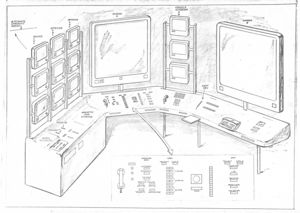First-Hand:Bell Labs and 2001: A Space Odyssey
Submitted by A. Michael Noll
April 25, 2018
© Copyright 2018 AMN
A very thoroughly researched book by Michael Benson about the making of the movie 2001: A Space Odyssey was recently published in 2018, the 50th anniversary of the release of this movie.[1] A description of the contribution made to the movie by John R. Pierce and myself of Bell Labs is mentioned on page 125 of the Benson book. Benson credits us with "the film's prescient portrayal of our screen-based future." This current essay is a detailed elaboration of my memories of my work at Bell Labs with Pierce on 2001: A Space Odyssey.
John R. Pierce was executive director of communication research at Bell Labs and was my boss’s, boss’s, boss. Pierce reported directly to William O. Baker, who was Vice President, Research at Bell Telephone Laboratories, Inc. (known as Bell Labs) in Murray Hill, NJ. Pierce was extremely creative, having coined the term “transistor” and having led the team that made the first communications satellite, Telstar. Pierce also wrote his own science fiction, under a pseudonym (J. J. Coupling). Pierce was friendly with Arthur C. Clarke – they had similar interests: science fiction and communication satellites.
The technology consultants for the movie, Fred Ordway and his people, visited Bell Labs in 1965. Pierce wrote a draft scenario for the use of a video telephone call from the space station orbiting the Earth, Pierce wrote a note[2] to W. O. Baker (VP, Research) and other senior managers at Bell Labs, including a draft of his memorandum describing communications equipment for 2001. Pierce related that he recently saw Arthur C. Clarke and Frederick I. Ordway, III, and they enlisted his help “concerning communication equipment for a very lush science fiction picture” which they were making. Pierce wrote that he “agreed because I’d rather have us than General Telephone or someone else exercise what influence can be exercised. I’d even like a Blue Bell on the telephone booth.” Later Pierce wrote: “I don’t see how we can be misrepresented in a scene dated 2001.”
On June 29, 1965, Pierce sent Ordway his memorandum and then went on vacation. Pierce stated in the letter to Ordway that he had informed the Vice President for Public relations at AT&T about what he had doing for the picture. Ordway was president of Polaris Productions and was then staying in New York City. By the end of August, Ordway had returned to Britain, working on 2001.
Pierce asked me to design what the videophone would look like, along with technical details for its use, and also the communications center for the spaceship. I worked with the drafting department at Bell Labs on the drawings and finalized memoranda describing the video telephone booth and communications center. On September 7, 1965, I sent Ordway two memoranda: one described a telephone booth for orbiting space station,[3] and the second described a communication center for the space ship.[4] Both memoranda included the very-creative drawings made by the drafting department at Bell Labs. I included a copy of the Bell System seal and its exact dimensions. Ordway acknowledged receipt of my materials, in a latter to me dated October 13, 1965. When I finally saw the movie years later, I was surprised to see everything used exactly as I had indicated, even including a Bell System logo on the wall outside the booth.
After the movie appeared in early 1968, a manager at AT&T telephoned me to complain strongly that the Bell System seal had been used in the movie. AT&T objected because the use of the Bell seal implied that the Bell System was providing telecommunication service outside the United States, which court decree forbade it from doing. When I told the AT&T person that Pierce had approved my effort I was saved from the wrath. Pierce defended the use of the seal – but AT&T’s objection was too late anyway, since the film was being shown all over the planet. Pierce clearly was well aware of the concerns of some parties at AT&T and seemed to be defying them. Pierce was known for his confrontational approach, and few wanted to tangle or disagree with him. The Bell System was broken up in 1984, and thus the Bell seal in a movie dated 2001 really did not matter.
On the 25th anniversary of 2001, the Bell Labs News had an article about the movie, including a photo of John Pierce and his wife Brenda eating popcorn while watching the movie.[5] A copy of the drawing of the booth was also included in the article.
I knew John Pierce quite well, and was honored when he asked me to be the co-author of a new edition of his book Signals.[6] I never met Arthur C. Clarke, but did program and create the computer-animated title sequence for his 1970 NBC TV special “The Unexplained,” directed by Walt deFaria of Lee Mendelson Productions. Pierce’s papers and books are at The Huntington Library in San Marino, CA.
References
- ↑ Michael Benson, Space Odyssey, Simon & Schuster (New York), 2018.
- ↑ J. R. Pierce, memo dated June 25, 1965, Subject: Memorandum “Communications Equipment for ‘2001’.” (pdf)
- ↑ A. Michael Noll, “Phone Booth for Orbiting Space Station,” (pdf) September 3, 1965.
- ↑ A. Michael Noll, “Communication Center for ‘2001’,” August 2, 1965.
- ↑ Dan Van Atta, “Film Institute Pays Tribute To a Timeless Odyssey: 2001,” Bell Labs News, Vol. 3, No. 8, April 19, 1993, pp. 3 & 7.
- ↑ John R. Pierce and A. Michael Noll, SIGNALS: The Science of Telecommunication, Scientific American Books (New York, NY), 1990.

